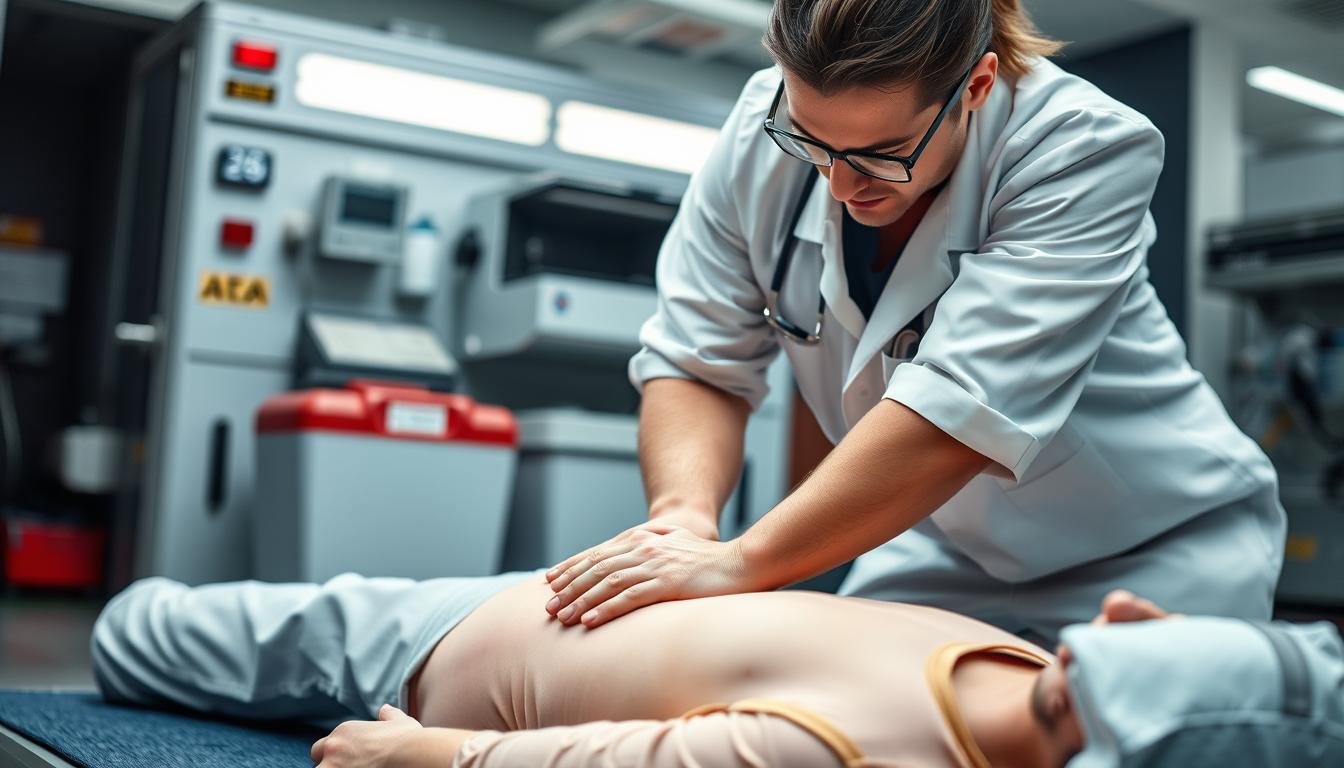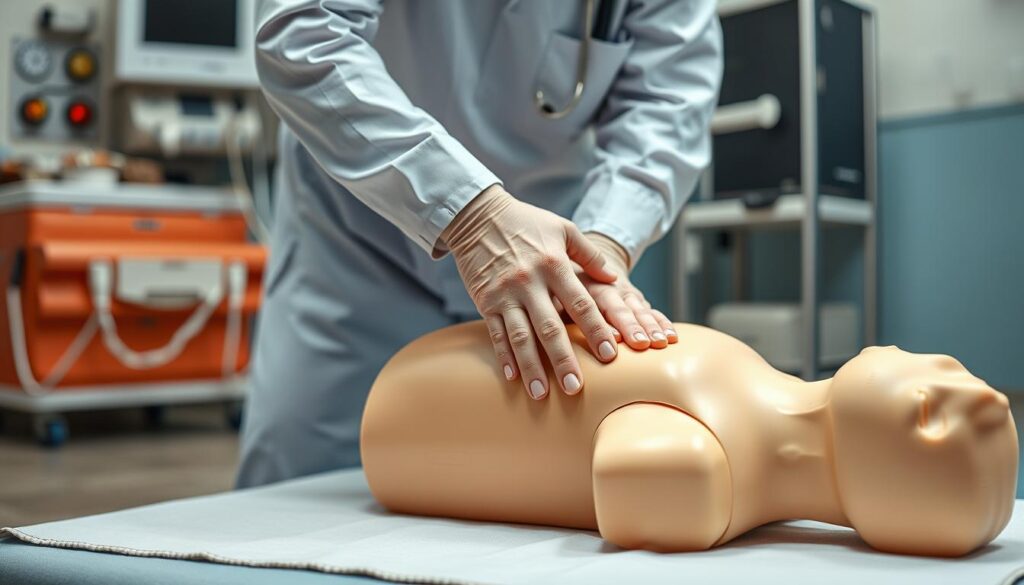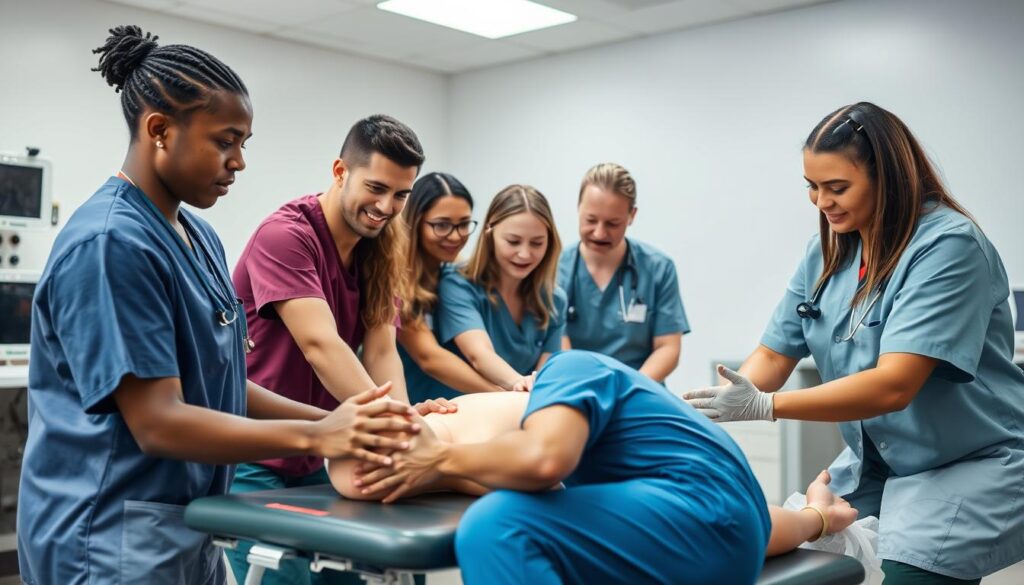Cardiac emergencies need quick and precise actions. Getting a high chest compression fraction can really help save lives. Doctors say the quality of chest compressions is key to helping patients in cardiac arrest.
A high chest compression fraction means more time for chest compressions during CPR. Studies show that keeping a CCF of at least 80% greatly boosts survival chances for heart attack patients.
Research shows that 70% of survival chances in heart attacks depend on chest compression quality. Big studies found an average CCF of 74%. This shows we can do better in saving lives during emergencies.
Key Takeaways
- Chest compression fraction directly impacts patient survival rates
- 80% CCF is the gold standard for effective CPR
- Continuous, uninterrupted compressions are critical
- Professional training enhances compression quality
- Quick rescuer rotation prevents fatigue and maintains compression effectiveness
- Proper technique is more important than duration
- Real-time feedback can optimize compression performance
Understanding Chest Compression Fraction and Its Importance
Surviving cardiac arrest depends on good CPR. Getting the chest compression fraction (CCF) right is key to better patient outcomes.
Chest Compression Fraction is how much time is spent on chest compressions during CPR. Teams try to hit 80% CCF or more. This helps blood flow to important organs.
What is Chest Compression Fraction?
CCF is found by comparing chest compression time to total CPR time. For example, 8 minutes of chest compressions in a 10-minute CPR session is an 80% chest compression fraction.
Impact on Patient Survival Rates
- Studies of 13,000 patients showed a median CCF of 74%
- 25.6% of patients got Return of Spontaneous Circulation (ROSC)
- Only 2.4% of patients made it to discharge
“Higher Chest Compression Fraction increases the likelihood of achieving ROSC, but does not guarantee long-term survival.”
Current CCF Standards and Guidelines
Doctors follow certain rules to get the best chest compression fraction:
- Compression rate: 100-120 compressions per minute
- Compression depth: At least 2 inches for adults
- Minimize interruptions: Less than 10 seconds between compressions
Knowing and following these guidelines can greatly help a patient’s chance of survival in cardiac emergencies.
How Can You Achieve a High Chest Compression Fraction
A high chest compression fraction (CCF) is key for good CPR. The American Heart Association says we need at least 80% CCF to help patients live. This part talks about how to do better chest compressions and improve CPR skills.
Proper Hand Placement and Technique
Getting a high chest compression fraction starts with the right hand placement. Hands should be on the lower sternum for best force. Using the right technique means:
- Hands in the chest’s center
- Arms straight and shoulders over hands
- Using body weight for force
Maintaining Optimal Compression Depth and Rate
Good chest compressions need the right depth and speed. Here are the best settings:
| Compression Parameter | Recommended Value |
|---|---|
| Depth | 2-2.4 inches (5-6 cm) |
| Rate | 100-120 compressions per minute |
Managing Rescuer Fatigue Effectively
Getting tired can lower chest compression fraction. Ways to fight fatigue include:
- Switching team members often
- Keeping a good body position
- Doing short, focused compressions
“Consistent, high-quality chest compressions are the cornerstone of successful resuscitation efforts.” – Emergency Medical Professionals
Using these methods can greatly boost chest compression fraction and save more lives.
Minimizing Interruptions During CPR
Getting a high chest compression fraction means no breaks in heart pushes. Every stop in pushing can hurt a patient’s chance to live. Studies say keeping the heart pushes going is key to saving lives.
“Minimizing interruptions is the key to successful CPR and achieving optimal chest compression fraction”
Doctors need to find ways to cut down on breaks during CPR. Things that often stop chest pushes include:
- Rhythm assessment
- Pulse checks
- Medication administration
- Equipment setup
The aim is to get a chest compression fraction of 80% or more. A study found the average CCF was 74%, showing a lot of room for better. Fast teamwork can help cut down on these stops.
Ways to lessen pauses include:
- Having emergency gear ready
- Assigning clear roles
- Practicing quick team changes
- Using feedback systems
Tools like ZOLL monitoring systems can track and improve chest push quality. This could double survival rates in heart emergencies.
Keeping chest compressions going is more than a skill—it’s a lifesaver. It can be the difference between life and death.
Team Coordination and Communication Strategies
Good team work is key to keeping chest compressions high during CPR. Studies show that talking and working together well are crucial for saving lives.
To get a high chest compression fraction, it’s not just about one person’s skill. It’s about working together smoothly and clearly.
Clear Role Assignment
Teams that save lives have clear roles. Research shows important facts about team success:
- 98.6% of residents said they were unsure about their roles.
- 79.3% needed to understand their roles better.
- 100% said team training was key for working well together.
Efficient Provider Transitions
It’s important to keep chest compressions going without stops. Smooth handovers between team members help a lot.
“Precision in transitions can mean the difference between life and death.” – Emergency Medical Professionals
Real-time Feedback Implementation
Keeping communication open and giving feedback right away is crucial. Training has shown big improvements:
| Skill Area | Before Training | After Training |
|---|---|---|
| Team Leadership | 1.4% Confident | 95.1% Confident |
| Decision Making | 2.8% Certain | 98.6% Certain |
| Communication | 39.3% Comfortable | 96.5% Comfortable |
Keeping up with training and practice can really boost team skills in emergency situations.
Advanced Technologies and Tools for CCF Optimization
New technologies are changing how we help people in heart emergencies. Tools now give rescuers key insights into CPR. This lets healthcare workers make chest compressions better in real-time.
Technological innovations are changing how we save hearts. Devices that give feedback in real-time are big changes. They help rescuers keep compressions just right.
- Advanced electronic monitoring systems
- AI-powered CPR coaching platforms
- Wearable performance tracking devices
- Automated compression assistance tools
These advanced tools give quick info on important stats like:
| Metric | Optimal Range | Technology Impact |
|---|---|---|
| Compression Depth | 2-2.4 inches | Real-time visual/audio feedback |
| Compression Rate | 100-120 per minute | Digital metronome integration |
| Chest Compression Fraction | 80% or higher | Continuous performance tracking |
“Technology doesn’t replace training, but it significantly enhances our ability to deliver life-saving interventions.” – Emergency Medical Professional
Even with these tools, training is still key. Skills, quick thinking, and good judgment are still most important. They help us save lives in heart emergencies.
Conclusion
Getting a high chest compression fraction is key for good CPR. It can save lives in heart emergencies. This guide shows how to get better at CPR with the right training and skills.
Practicing often and knowing how to do CPR right is important. It helps people live longer in emergencies. This includes knowing how deep and fast to press, and not stopping too much.
New tools like real-time feedback and practice sessions have changed CPR training. They help people learn to press the chest right, at the right speed. This makes CPR better and saves more lives.
Anyone can learn to do CPR well. It’s important to keep learning and practicing. Knowing the latest CPR rules is also key.
Every second is crucial in heart emergencies. Your CPR skills could save someone’s life. Keep working on your skills to help others.
Improving at CPR is a never-ending journey. Use new training methods and learn from your mistakes. Stay dedicated to getting better at CPR.



